Technology in
aviation
The wing
How does a wing work? The drawing and text
below are made by "Science Joy
Wagon" and show how the wing works. Or in fact really does not...
Read the texts right of the drawings. This is the way of how
a law of Mr. Bernoulli is (mis)used to explain the effect.
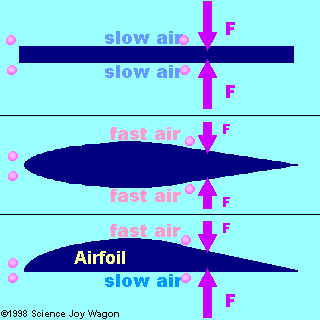 |
A
The
distance the air particle on top of the wing travels is just the same
as the particle under the wing. Each particle travels the distance in
the same time, so their speed is equal.
The forces above and under the wing are equal, so there is no lift.
|
B Now the wing is curved. The distance the air has
to travel is longer. The speed of the particles has increased.
However, the air
particles have to travel the same distance, so again, there is no
lift. |
C
In this
profile the upper particle travels a longer distance than the particle
below. The upper particle has an increased speed and presses less on
the top of the wing.
(It is the same as stating: The air on top of the wing is 'thinner'
than the air below).
So, pressure under the wing is higher and there is lift: the wing
wants to go up. |
At the
left you see a light aeroplane with wings detached.
The shape of the wing is clearly visible: the upper part is more curved
than the lower part of the wing.
Why holes in the wing? Read more in
the section "Light and strong" |
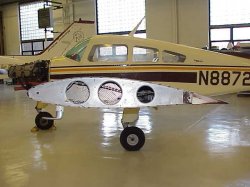 |
The wing of the aeroplane above does not look like
the "ideal" wing as showed in model C (see the drawing), but
more like model B and that profile should not work...
But there more arguments against the idea of Mr. Bernoulli:
- When the aeroplane flies upside down, it does
not work. The aeroplane would return to earth very fast because the
principle of lift would work reverse.
- Not all wings possess a curved top and a flat
underside:
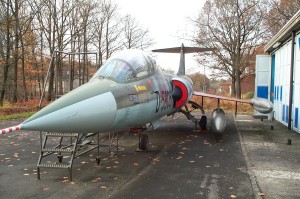 |
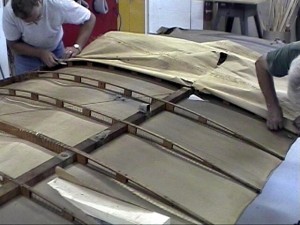 |
The Lockheed Starfighter has thin,
razor-sharp wings. |
A replica of the Wright Flyer. The
wings
are thin and the underside is a little hollow. |
- A Cessna aeroplane with a curved top and a
fairly flat underside would have to fly at least 700 km/h to get sufficient
lift.
- Aerobatic aeroplanes have a symmetrical wing
with a top and underside of the same shape.
- You can even use a barn-door as a wing, so all
wings create lift.
This is an easy way of telling how a wing works (but
again, this is not the full story):
 |
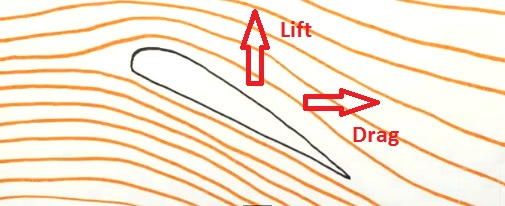 |
The kite lifts up
because the wind strikes past it. And the kite pulls the
rope substantially. |
The wing acts like a kite. Air skims
along the underside of the wing and deflects it.
This takes energy because the air encounters resistance, or drag while
touching
wing.
Because of the deflection of the air the wing moves upwards, but drag
moves
the wing backwards -like the kite. |
 Do you want to know more?
Do you want to know more?
Control
An aeroplane is controlled by control surfaces:
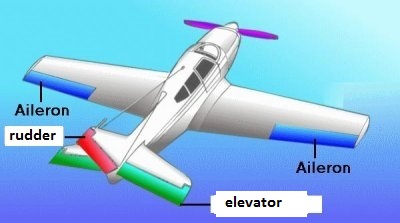
The blue surfaces are the ailerons. It just
means: "little wings". The red part is the rudder and the
green
surfaces are called the elevator.
Aileron
Ailerons are in fact little wings within the big wings.
They control this movement of the aeroplane, which is called roll:
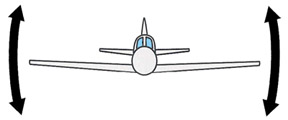
When one aileron goes up, the other goes down. How
does that work?
 |
aileron right:
normal lift |
 |
aileron down:
more lift |
 |
aileron up:
less lift |
(sideview of the ailerons)
What happens is this: because of the ailerons the
wing has more or less lift. When the left aileron goes up (less lift) and the
right down (more lift) the left wing will go down.
Elevator
The elevator controls the pitch of the
aeroplane:
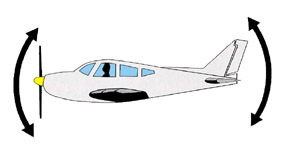
So, climbing and descending. And the
elevator surfaces move up and down simultaneously. So both up and both
down.
Not so with Concorde.... At the trailing edge of the Delta wings elevons
do the work of the ailerons and the elevator. So, both up: climbing. Both down:
descending. One up and one down: a roll.
 |
elevator upwards,
less lift and the the tail of the aeroplane goes down while the nose
rises |
 |
elevator
normal, the aeroplane flies horizontally |
 |
elevator down, more
lift and the tail rises while the nose goes down |
(Sideview of the elevator)
Rudder
The tail of the wing is no wing, but a large
surface. Because of the tail the aeroplane will fly better straight on. In
the tail is the rudder, which is in fact a part of the tail surface. The rudder
controls the yaw movement:
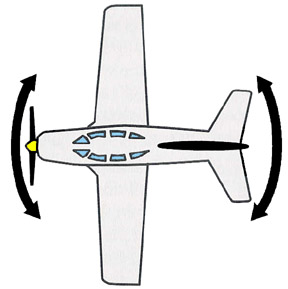
It's like the rudder of a ship:
 |
rudder left, tail
goes right |
 |
rudder normal,
aeroplane flies straight forward |
 |
rudder right, tail
goes left |
(Topview of the rudder)
How does the pilot control the flight
surfaces? This photo is made in the Lockheed Constellation
of the Aviodrome museum, Lelystad, Netherlands and shows the controls clearly:
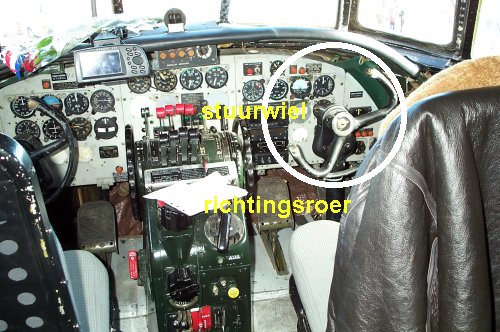
In front of the pilot is the steering column. Both
pilots have one and the columns are connected to each other. When the pilot
turns the control wheel (within the white circle) he will move the ailerons. In
the position this wheel is at the moment, it would move the left wing down. The
wheel is part of the column. If the pilot moves the column forward, the nose
will go down. If he pulls the column backwards, the nose goes up. The two pedals
behind the column are the controls of the rudder. To perform a turn, the pilot
uses both ailerons and rudder.
(Most pictures in this section are from
the Oscar Chanute Aerospace Museum en the Aviation History On-line Museum)
 Do you want to know more?
Do you want to know more?
The piston engine
The piston engine is an internal combustion engine, or Otto engine.
What does that mean? It's an old expression. A steam engine is an engine that
uses external combustion. A fire in or below the boiler turns water into steam
and by way of a pipe the steam enters the cylinder, which in turn moves the
piston and consequently the flywheel.
In an internal combustion engine combustion takes
place in the cylinder. There are two types: the Diesel engine and the Otto
engine. The Diesel in
general is heavy, because of the high pressures inside. The Otto engine runs on
petrol (or gasoline) which is ignited by a spark-plug. This is the piston engine
used in the majority of aeroplanes. (But recently, also lightweight Diesels
are used in aviation, they use jet fuel...)
Most of the Otto engines use pistons that go up
and down. Look at this drawing of German origin:
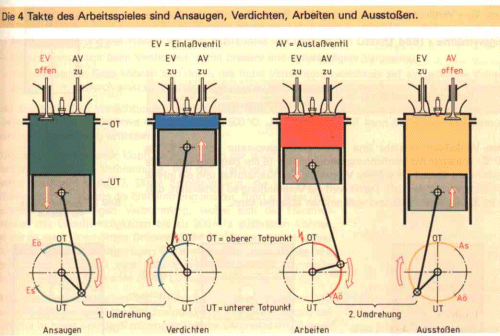
Put your imagination at work:
This drawing only shows one cylinder, but there
are aeroplane engines flying with 18 cylinders or more. Each cylinder has two
valves which can be opened or closed. In this drawing EV is the inlet
valve AV is the exhaust valve. The piston is coloured grey. The piston is
connected to the crankshaft by means of a piston rod, or connecting rod.
In the drawing this is represented by a circle. In a car the crankshaft is
connected to a flywheel to keep the momentum. In an aero engine this work is done by the propeller. It's a way of making the engine run smoothly. On top, between the valves, there is
the spark-plug. The only thing it has to do is to spark at the right moment.
In the green drawing
the inlet valve is opened and the piston goes down. An air-fuel mixture is drawn
in.
This mixture origins in the carburettor.
In the blue drawing
the piston goes up again. The inlet valve is now closed and the fuel mixture is
trapped. It is to be compressed.
In the red drawing at
last work starts. Note that both valves are closed now. Just before the
piston reaches the top of the cylinder, the sparkplug sparks and the mixture
ignites. A detonation follows, or more precisely: a very fast combustion.
Pressure in the cylinder rises high and there is only one way to lower the
pressure: the piston. The piston is forced to go down. In a nutshell, this is how
the piston engine works.
In the yellow drawing
the piston goes up again and the exhaust gasses are pressed into the exhaust
pipe of the engine, through the exhaust valve.
These steps are repeated over and over again and
this is how the engine runs. See it again in this animation:
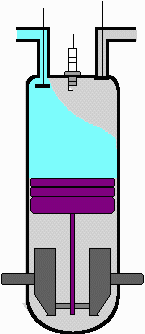
To make things more complicated, below one of the
most powerful piston engines known in aviation is shown, the Wright Cyclone R 3350
of the Super Constellation. Eighteen cylinders in two rows of nine. Strong? Oh
Yeah, 3500 horsepower!
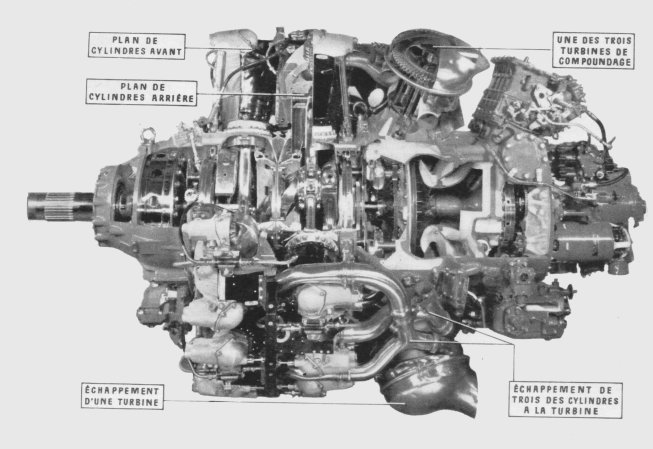
An engine like the Wright is called a radial
engine. This animation shows a radial, but less complicated compared to the
Wright above:

The jet engine
 The
jet engine is a combustion engine too, but quite different from the piston
engine. It has very little moving parts, compared to a piston engine. To tell
you how it works I will start with the Advent mill.
The
jet engine is a combustion engine too, but quite different from the piston
engine. It has very little moving parts, compared to a piston engine. To tell
you how it works I will start with the Advent mill.
In the Netherlands and Germany this is used at and before Christmas time. If you
light the candles it will start to turn because of the rising heat of the candles. On
top of the mill is a disc with little wings. Rising air causes the wings to
move. This makes the mill turn around. This disc could be called a turbine.
Remember this word because it will be mentioned later in this section.
A jet engine uses hot air too. It leaves the engine
at one side. That is why the engine will move to one side. The jet engine
extracts air from the surrounding atmosphere. That is why it has to suck that
air in. This is done at the front of the engine.
The air is compressed by the compressor. After that it is blown into the combustion
chamber. Fuel is sprayed into the chamber and ignited by a spark. So while
the air inside has become red-hot, it leaves the exhaust pipe. In fact, there is
more coming out of the exhaust, than had entered the inlet of the engine, so it wants to move to one direction.
But how is the compressor powered? Let's take a
look at the drawing on the right.
The jet engine looks like a long tube with a lot of moving vanes (little
wings) and stationary vanes. The moving or rotary vanes are attached to a shaft,
which is in turn rotating in bearings at the front and the rear of the engine.
Now let's have a look at the drawing.
If we could split the engine with a saw, it would look like what you see at the right.
The green characters will explain what you'll see.
Air is sucked in through the compressor stages C.
These consist of many little wings mounted on discs. They turn very fast. They
suck in air and compress it, like the bicycle pump. And, in the same way the
compressed air heats.
After that the compressed air enters the combustion chamber V.
Fuel is injected and ignited. The hot gasses leave the turbine T.
Because the turbine is connected to the compressor by a shaft, the compressor
turns too.
It's a cycle! In fact, all four stages of the piston engine (air in,
compression, combustion and exhaust) are combined in one flow of the air through
the engine.
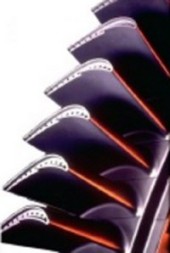 |
The turbine is made
of many little "scoops", or turbine blades.
Hot gasses cause them to move, so the turbine disc starts turning very
fast.
The turbine blades are really wonders....
They are capable of extracting 500 horsepower a piece from
the hot gasses. They work at a temperature higher than the
melting point of the materials they are made of. To prevent
melting, they are cooled by means of very little holes in the blades.
Turbine blades are light, about 100 grams in metric. But the centrifugal
forces are enormous, so the blades appear to weigh about 4000
kilos.
And yet there is hardly a problem..... |
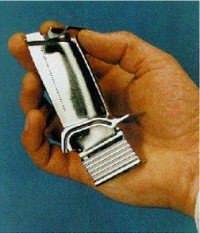 |
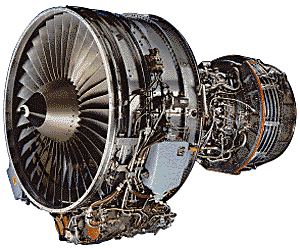 The hot gasses leaving the
turbine propel the aeroplane to which the jet engines are attached, with an
enormous force.
The hot gasses leaving the
turbine propel the aeroplane to which the jet engines are attached, with an
enormous force.
On the left a real jet engine is shown. You will
never see this at the airport or in flight because cowlings prevents seeing
this. Cowlings make the engines look more smooth and have a streamlining
purpose.
The cutaway jet engine above (with the green characters) is a turbojet.
All air passes the engine. This type of engine is used for fast aeroplanes like
fighters. Besides, these fighters need an engine with a small frontal area.
In many cases the turbofan is used.
In the turbofan the major part of the air passes outside the engine itself.
In modern engines, for every amount of air that passes the engine itself, eight
times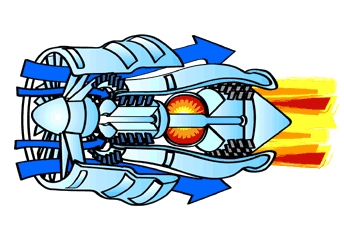 more air is blown
along the outside of the engine itself. The big fan in front can be compared to
a propeller with a lot of blades. The turbofan is more economic and more silent
because the exhaust gasses mix with the cool air.
more air is blown
along the outside of the engine itself. The big fan in front can be compared to
a propeller with a lot of blades. The turbofan is more economic and more silent
because the exhaust gasses mix with the cool air.
If a free running turbine is added, this will
turn too and can drive a propeller in front of the engine. At nearly all
ocasions by way of a gearbox, to slow down the rotation speed. This is called a turboprop.
These turboprops are used on the Fokker F-50 or the Lockheed Hercules.
 Do you want to know more?
Do you want to know more?
Light and strong
An aeroplane must be light, but also strong. This
is a contradiction!. If something is light, it often is not strong. If
something is strong, it is probably heavy. But fortunately there are ways to
make objects strong without a lot of weight. You can test it yourself with a
piece of paper:
 |
 |
| the paper
strip bends |
the paper strip is on
its side and it
does not bend |
 Wow,
we can use that to make a square tube. None of the sides can bend because all
Wow,
we can use that to make a square tube. None of the sides can bend because all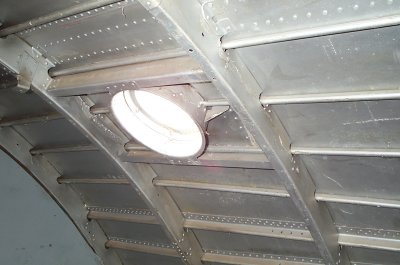 blades are supported by "a blade on its side". The object has become
stronger. Aircraft manufacturers use these tubes all over the aeroplane. The
photo shows how this is used in the Lockheed Constellation.
blades are supported by "a blade on its side". The object has become
stronger. Aircraft manufacturers use these tubes all over the aeroplane. The
photo shows how this is used in the Lockheed Constellation.
It shows the hull of the aeroplane, where the passengers are seated. In this case, the tubes are rounded off a little.
The real name of these shapes is stringers. The little ones run in the
length of the hull and the big ones are circles in the width.
The next photo shows the hull being filled up with such circles. These make the
hull very strong.
In the circles are holes. In this way the circles
stay strong, but with a lesser weight.
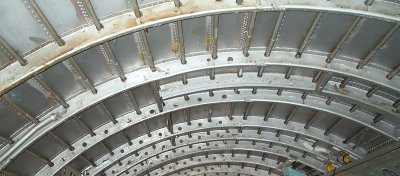
At right a wing of a Douglas DC-3 wing is shown. The
bulkheads in the wing are perforated. This is to reduce weight. The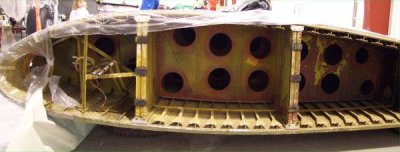 ribs are stringers, but this time not in the shape of a tube. However, they act
the in same way: they increase the strength.
ribs are stringers, but this time not in the shape of a tube. However, they act
the in same way: they increase the strength.
There are many
ways to shape light materials to strong parts. For instance, they can be made of
one piece. A perfect example is shown below left. It is one of the four "legs"
of the Boeing 747's main landing gear. There
is a nose gear as well, but the major forces are on the main landing gear. At
the start there can be a weight of 100.000 kilos on each gear. That is the
weight of a hundred cars!
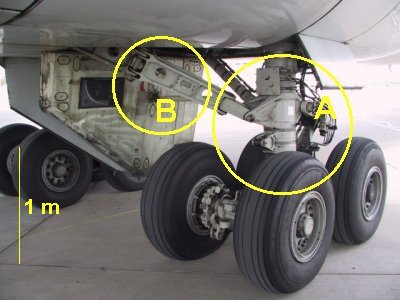 By
removing a lot of material from a solid block of steel, the manufacturer
achieves a
strong shape. Much of the material is waste, which can be recycled.
By
removing a lot of material from a solid block of steel, the manufacturer
achieves a
strong shape. Much of the material is waste, which can be recycled.
Another example is of removing material is shown
at B. It is one of the two studs which are used to prevent the gear of
collapsing. Holes are made in it, so it is strong, but a little lighter.
Steel is quite heavy. There are strong materials
which are light at the same time, titanium for instance.
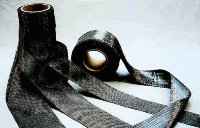
Very modern is the increasing use of plastics, or synthetic materials. I do
not mean the plastic of a washing-up bowl. No, it's composite material, which is
vastly stronger. Composite means the material is composed of different materials.
For instance layers of carbon fibers (right). These are glued together with
resin and afterwards heated in a kind of oven. The composite products are very
strong. The new Boeing 787 for a major part is built of composites. Racing-cars too.
The Dutch company Stork Fokker produces a
material that is called Glare. It consists of two thin layers of
aluminium and between these layers glass fibre covered in resin. This also acts
like glue. The material is light and strong. Furthermore, it is very resistant to
the forming of little cracks, when the material is stressed.
 Glare
is used for a part in the Airbus A380, the biggest passenger aeroplane in the
world.
Glare
is used for a part in the Airbus A380, the biggest passenger aeroplane in the
world.
If you take a close look at the panel left, you can see windows and a door of
the big A380.
The website http://www.airbus.com/aircraftfamilies/passengeraircraft/a380family/
shows the A380. The maiden flight took place on April 27th, 2005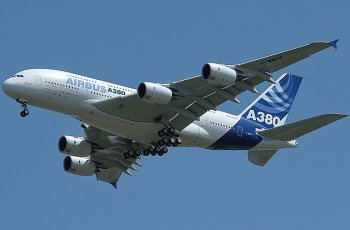 .
.
 Back
to the homepage
Back
to the homepage















 The
jet engine is a combustion engine too, but quite different from the piston
engine. It has very little moving parts, compared to a piston engine. To tell
you how it works I will start with the Advent mill.
The
jet engine is a combustion engine too, but quite different from the piston
engine. It has very little moving parts, compared to a piston engine. To tell
you how it works I will start with the Advent mill.


 The hot gasses leaving the
turbine propel the aeroplane to which the jet engines are attached, with an
enormous force.
The hot gasses leaving the
turbine propel the aeroplane to which the jet engines are attached, with an
enormous force.  more air is blown
along the outside of the engine itself. The big fan in front can be compared to
a propeller with a lot of blades. The turbofan is more economic and more silent
because the exhaust gasses mix with the cool air.
more air is blown
along the outside of the engine itself. The big fan in front can be compared to
a propeller with a lot of blades. The turbofan is more economic and more silent
because the exhaust gasses mix with the cool air.

 Wow,
we can use that to make a square tube. None of the sides can bend because all
Wow,
we can use that to make a square tube. None of the sides can bend because all blades are supported by "a blade on its side". The object has become
stronger. Aircraft manufacturers use these tubes all over the aeroplane. The
photo shows how this is used in the Lockheed Constellation.
blades are supported by "a blade on its side". The object has become
stronger. Aircraft manufacturers use these tubes all over the aeroplane. The
photo shows how this is used in the Lockheed Constellation.
 ribs are stringers, but this time not in the shape of a tube. However, they act
the in same way: they increase the strength.
ribs are stringers, but this time not in the shape of a tube. However, they act
the in same way: they increase the strength. By
removing a lot of material from a solid block of steel, the manufacturer
achieves a
strong shape. Much of the material is waste, which can be recycled.
By
removing a lot of material from a solid block of steel, the manufacturer
achieves a
strong shape. Much of the material is waste, which can be recycled.
 Glare
is used for a part in the Airbus A380, the biggest passenger aeroplane in the
world.
Glare
is used for a part in the Airbus A380, the biggest passenger aeroplane in the
world. .
.